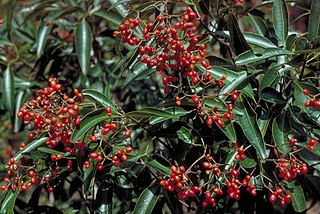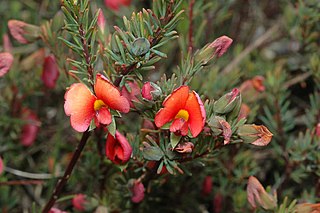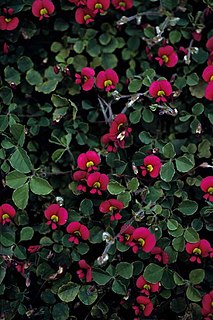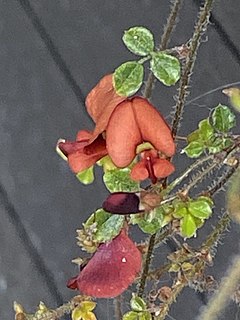
Pandorea jasminoides, also known by the common names bower of beauty and bower vine, is a species of flowering plant in the family Bignoniaceae and is endemic to eastern Australia. It is a woody climber with pinnate leaves that have three to nine egg-shaped leaflets, and white or pink trumpet-shaped flowers that are red and hairy inside. It is also grown as an ornamental.

Kennedia is a genus of 13 species of flowering plants in the in the pea family Fabaceae and is endemic to Australia. Plants in this genus are prostrate or climbing perennials with trifoliate leaves and large, showy, pea-like flowers. There are species in all Australian states.

Kennedia coccinea, commonly known as coral vine, is a species of flowering plant in the family Fabaceae and is endemic to the south-west of Western Australia. It is a twining, climbing or prostrate shrub with trifoliate leaves and orange-pink, red and pink, pea-like flowers.

Gompholobium ecostatum, commonly known as dwarf wedge-pea, is a species of flowering plant in the family Fabaceae and is endemic to southern Australia. It is a low-lying to erect shrub with trifoliate leaves with linear to lance-shaped leaflets, and apricot-coloured to reddish, sometimes yellow flowers.

Melicope elleryana, commonly known as pink flowered doughwood, pink evodia, corkwood, or saruwa, is a species of rainforest shrub or tree in the family Rutaceae, and is native to New Guinea, parts of eastern Indonesia, the Solomon Islands and northern Australia. It has trifoliate leaves and pink to white, bisexual flowers arranged in panicles in leaf axils.

Gompholobium huegelii, commonly known as common wedge-pea is a species of flowering plant in the family Fabaceae and is endemic to south-eastern Australia. It is an erect or spreading shrub with trifoliate leaves and cream-coloured to yellow and greenish, pea-like flowers.

Sambucus australasica, commonly known as yellow elderberry, native elderberry or native elder, is a species of flowering plant in the family Adoxaceae and is endemic to eastern Australia. It is a shrub or small tree with pinnate leaves that have coarse teeth on their edges, small white flowers with three petals, and yellow fruit. It is usually found in and on the edges of rainforest.
Melicope contermina is a species of shrub or small tree in the family Rutaceae and is endemic to Lord Howe Island. It has trifoliate leaves and white flowers borne in leaf axils in panicles of nine to fifteen flowers.

Kennedia lateritia, commonly known as Augusta kennedia, is a species of flowering plant in the family Fabaceae and is endemic to the south-west of Western Australia. It is a woody climber with twining stems, trifoliate leaves and orange-red and yellow flowers arranged in groups of up to twenty-four.

Zanthoxylum ovalifolium, commonly known as thorny yellowwood, oval-leaf yellow wood or little yellowwood, is a species of flowering plant in the family Rutaceae. It is a shrub or tree usually with trifoliate leaves, white, male and female flowers arranged in panicles in leaf axils or on the ends of branchlets and red, purple or brown follicles.

Dinosperma is a genus of plant containing the single species Dinosperma erythrococcum, commonly known as tingletongue, clubwood or nutmeg, and is endemic to north-eastern Australia. It is a tree usually with trifoliate leaves arranged in opposite pairs, the leaflets lance-shaped to oblong, and panicles of small white flowers, later bright orange to red, slightly fleshy follicles containing shiny, bluish black seeds.
Melicope affinis is a species of shrub or tree in the family Rutaceae and is endemic to Queensland. It has trifoliate leaves and small greenish white flowers borne in panicles in leaf axils.
Gompholobium karijini is a species of flowering plant in the family Fabaceae and is endemic to the north-west of Western Australia. It is an erect, openly-branched shrub with pinnate leaves with five to ten pairs of leaflets, and racemes of yellow to orange and creamy-yellow, pea-like flowers.
Gompholobium oreophilum is a species of flowering plant in the family Fabaceae and is endemic to the north-west of Western Australia. It is an erect shrub with pinnate leaves with elliptic leaflets, and racemes of yellow to orange and creamy-yellow, pea-like flowers.

Gompholobium uncinatum, commonly known as red wedge pea, is a species of flowering plant in the family Fabaceae and is endemic to eastern Australia. It is a small, low-lying shrub with trifoliate leaves, the leaflets linear to narrow lance-shaped, and red, or orange-red and yellow-green, pea-like flowers.

Gompholobium virgatum, commonly known as leafy wedge pea, is a species of flowering plant in the family Fabaceae and is endemic to eastern Australia. It is a erect or sprawling shrub with trifoliate leaves, the leaflets narrow egg-shaped with the narrower end towards the base, and yellow and greenish, pea-like flowers.

Kennedia beckxiana, commonly known as Cape Arid kennedia, is a species of flowering plant in the family Fabaceae and is endemic to the south-west of Western Australia. It is a prostrate or twining shrub or a climber with trifoliate leaves and red and yellow, pea-like flowers.

Kennedia carinata is a species of flowering plant in the family Fabaceae and is endemic to the south-west of Western Australia. It is a prostrate shrub with trifoliate leaves and reddish-purple, pea-like flowers.

Kennedia glabrata, commonly known as Northcliffe kennedia, is a species of flowering plant in the family Fabaceae and is endemic to the south-west of Western Australia. It is a prostrate shrub or creeper with trifoliate leaves and orange-pink to red flowers with a yellow centre.

Kennedia microphylla is a species of flowering plant in the family Fabaceae and is endemic to the south-west of Western Australia. It is a prostrate, mat-forming creeper with relatively small, trifoliate leaves and red flowers.
















